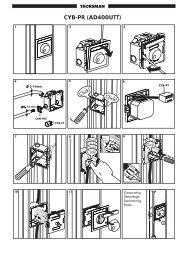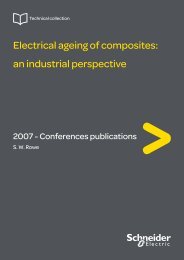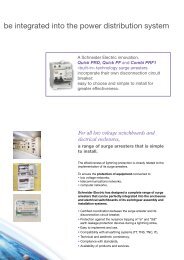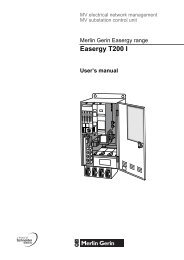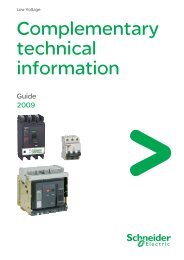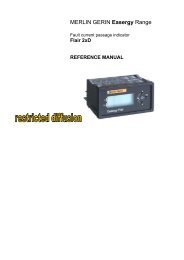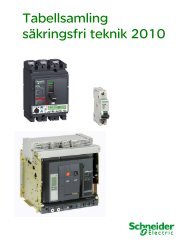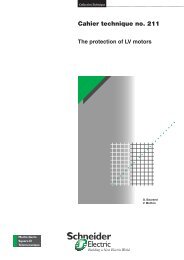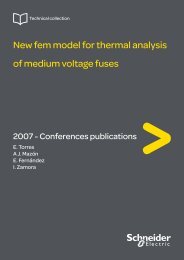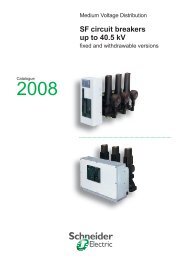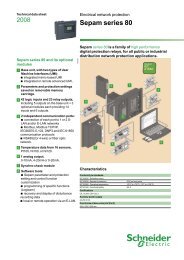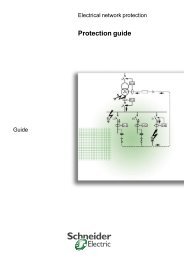Medium voltage switchgear application guide
Medium voltage switchgear application guide
Medium voltage switchgear application guide
You also want an ePaper? Increase the reach of your titles
YUMPU automatically turns print PDFs into web optimized ePapers that Google loves.
<strong>Medium</strong> <strong>voltage</strong> <strong>switchgear</strong> <strong>application</strong> <strong>guide</strong><br />
Appendix 2: motor<br />
(cont’d)<br />
4 - DIFFERENT MEDIUM VOLTAGE MOTORS<br />
Alternating and 100 kW current to 40 MW medium ranges. <strong>voltage</strong> motors are situated in the2 kV to 14 kV<br />
The <strong>application</strong>s motors can are be given classed in the in table 4 families below. whose main characteristics and<br />
motor characteristics, advantages <strong>application</strong>s<br />
type<br />
drawbacks<br />
asynchronous ■ highly robust due to their ■ intensive use<br />
motors with simple construction ■ aggressive or<br />
single cage, ■ hardly any on-load speed dangerous atmosphere<br />
double cage,<br />
or deep slots<br />
variation<br />
■ high quantity of reactive power<br />
absorbed with weak load<br />
asynchronous ■ easy optimisation of starting ■ machines with high starting<br />
motors with torque or signal torque<br />
widing rotor ■ rotor resistances and rings needing ■ machine needing strong<br />
adjustment and maintenance<br />
counter-current breaking<br />
■ power factor usually<br />
■ tending to give way to<br />
lower than 0.9<br />
double cage motors<br />
synchronous ■ same technology as ■ P > to 2000 kW<br />
motors<br />
alternators<br />
■ high transient state<br />
■ good output and good power<br />
factor<br />
synchronised ■ mixture of two previous ones: ■ tending to disappear<br />
asynchronous good starting torque and good<br />
motors<br />
power factor<br />
■ complex starting co-ordination<br />
5 - DIFFERENT MV ASYNCHRONOUS MOTOR STARTING TYPES<br />
J L<br />
J C J L<br />
J C<br />
J N<br />
J L J L<br />
J R3<br />
M<br />
R 3<br />
J R2<br />
R 2<br />
J R1<br />
M<br />
M<br />
M<br />
R 1<br />
date<br />
11/94<br />
- B•3•2 -<br />
revised<br />
05/2004<br />
direct auto-transformer reactance rotors<br />
6 - ASYNCHRONOUS MOTOR CHARACTERISTICS<br />
Direct characteristics<br />
asynchronous starting<br />
<strong>voltage</strong><br />
are motors<br />
power<br />
The the most widely used.<br />
starting current<br />
influencing main characteristics motor operation no-load current<br />
are opposite. given in the table<br />
asynchronous motor<br />
2 kV to 14 kV<br />
100 kW to 40 MW<br />
6 to 7 times motor I n<br />
≈ 0.3 times motor I n<br />
starting current cos ϕ 0.1 to 0.2<br />
no-load current cos ϕ ≈ 0.1<br />
load current cos ϕ 0.7 to 0.9<br />
page 5



